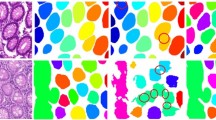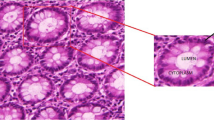Abstract
Analysis of the shape of glands and their lumen in digitised images of Haematoxylin & Eosin stained colon histology slides can provide insight into the degree of malignancy. Segmenting each glandular component is an essential prerequisite step for subsequent automatic morphological analysis. Current automated segmentation approaches typically do not take into account the inherent rotational symmetry within histology images. We incorporate this rotational symmetry into an encoder-decoder based network by utilising group equivariant convolutions, specifically using the symmetry group of rotations by multiples of 90\(^\circ \). Our rotation equivariant network splits into two separate branches after the final up-sampling operation, where the output of a given branch achieves either gland or lumen segmentation. In addition, at the output of the gland branch, we use a multi-class strategy to assist with the separation of touching instances. We show that our proposed approach achieves the state-of-the-art performance on the GlaS challenge dataset.
Access this chapter
Tax calculation will be finalised at checkout
Purchases are for personal use only
Similar content being viewed by others
Notes
- 1.
Rigidly rotating a histopathology image neither increases nor decreases its information content. It is the information content, not the geometry, that is symmetric under rotation.
- 2.
References
Chen, H., Qi, X., Yu, L., Dou, Q., Qin, J., Heng, P.A.: Dcan: deep contour-aware networks for object instance segmentation from histology images. Med. Image Anal. 36, 135–146 (2017)
Cohen, T., Welling, M.: Group equivariant convolutional networks. In: International Conference on Machine Learning, pp. 2990–2999 (2016)
Cohen, T.S., Welling, M.: Steerable CNNs. arXiv preprint arXiv:1612.08498 (2016)
Graham, S., et al.: MILD-Net: minimal information loss dilated network for gland instance segmentation in colon histology images. Med. Image Anal. 52, 199–211 (2018)
He, K., Zhang, X., Ren, S., Sun, J.: Deep residual learning for image recognition. In: Proceedings of the IEEE Conference on Computer Vision and Pattern Recognition, pp. 770–778 (2016)
Long, J., Shelhamer, E., Darrell, T.: Fully convolutional networks for semantic segmentation. In: Proceedings of the IEEE Conference on Computer Vision and Pattern Recognition, pp. 3431–3440 (2015)
Raza, S.E.A., et al.: Micro-Net: a unified model for segmentation of various objects in microscopy images. Med. Image Anal. 52, 160–173 (2019)
Ronneberger, O., Fischer, P., Brox, T.: U-Net: convolutional networks for biomedical image segmentation. In: Navab, N., Hornegger, J., Wells, W.M., Frangi, A.F. (eds.) MICCAI 2015. LNCS, vol. 9351, pp. 234–241. Springer, Cham (2015). https://doi.org/10.1007/978-3-319-24574-4_28
Sirinukunwattana, K., et al.: Gland segmentation in colon histology images: the glas challenge contest. Medi. Image Anal. 35, 489–502 (2017)
Veeling, B.S., Linmans, J., Winkens, J., Cohen, T., Welling, M.: Rotation equivariant CNNs for digital pathology. arXiv preprint arXiv:1806.03962 (2018)
Washington, M.K., et al.: Protocol for the examination of specimens from patients with primary carcinoma of the colon and rectum. Arch. Pathol. Lab. Med. 133(10), 1539–1551 (2009)
Worrall, D.E., Garbin, S.J., Turmukhambetov, D., Brostow, G.J.: Harmonic networks: deep translation and rotation equivariance. In: 2017 IEEE Conference on Computer Vision and Pattern Recognition (CVPR), pp. 7168–7177. IEEE (2017)
Xu, Y., et al.: Gland instance segmentation using deep multichannel neural networks. IEEE Trans. Biomed. Eng. 64(12), 2901–2912 (2017)
Author information
Authors and Affiliations
Corresponding author
Editor information
Editors and Affiliations
Rights and permissions
Copyright information
© 2019 Springer Nature Switzerland AG
About this paper
Cite this paper
Graham, S., Epstein, D., Rajpoot, N. (2019). Rota-Net: Rotation Equivariant Network for Simultaneous Gland and Lumen Segmentation in Colon Histology Images. In: Reyes-Aldasoro, C., Janowczyk, A., Veta, M., Bankhead, P., Sirinukunwattana, K. (eds) Digital Pathology. ECDP 2019. Lecture Notes in Computer Science(), vol 11435. Springer, Cham. https://doi.org/10.1007/978-3-030-23937-4_13
Download citation
DOI: https://doi.org/10.1007/978-3-030-23937-4_13
Published:
Publisher Name: Springer, Cham
Print ISBN: 978-3-030-23936-7
Online ISBN: 978-3-030-23937-4
eBook Packages: Computer ScienceComputer Science (R0)




